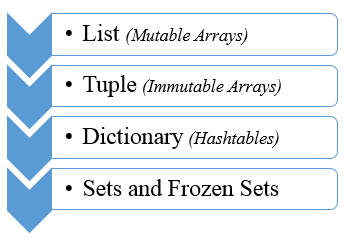Python Data Structures
What is a data structure?
A data structure is a highly specialized format designed for efficient organization and storage of data, enabling seamless execution of various operations. Each data structure is carefully crafted to cater to a specific purpose, ensuring accessibility and optimal utilization of the data. A proficient algorithm is often complemented by a well-crafted set of data structures, enabling efficient manipulation of the data. Among the most prevalent and widely recognized data structures is the array, which comprises a contiguous collection of data items accessible through an ordinal index.
Python Data Structures
Python provides four fundamental built-in data structures: list, tuple, dictionary, and set. The selection of an appropriate data structure depends on the nature of the data involved, whether it requires modification or remains fixed, and the desired access pattern (e.g., beginning, end, or random access). Throughout the upcoming chapters, we will explore how to effectively utilize each of these data structures, and how they significantly contribute to simplifying Python programming tasks.

Conclusion
Python offers a wide range of data structures to efficiently organize and manipulate data. Commonly used data structures in Python include lists, tuples, dictionaries, sets, and more, each serving specific purposes and providing various functionalities to cater to diverse programming needs. By using these versatile data structures, developers can optimize their code, enhance productivity, and effectively manage data in Python applications.